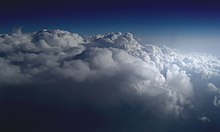This article needs additional citations for verification. (September 2008) |
| Stratocumulus clouds | |
|---|---|
 Aerial photograph of Stratocumulus perlucidus clouds over the midwestern United States | |
| Abbreviation | Sc |
| Symbol | |
| Genus | Stratocumulus (layer heap) |
| Species |
|
| Variety |
|
| Altitude | 500-2,000 m (2,000-7,000 ft) |
| Classification | Family C (Low-level) |
| Appearance | Thicker, dark gray, and somewhat conjoined heaps of clouds. |
| Precipitation | Uncommon Rain, Snow or Snow pellets |
A stratocumulus cloud, occasionally called a cumulostratus, belongs to a genus-type of clouds characterized by large dark, rounded masses, usually in groups, lines, or waves, the individual elements being larger than those in altocumulus, and the whole being at a lower height, usually below 2,000 metres (6,600 ft).[1][2] Weak convective currents create shallow cloud layers (see also: sea of clouds) because of drier, stable air above preventing continued vertical development. Historically, in English, this type of cloud has been referred to as a twain cloud for being a combination of two types of clouds.
- ^ World Meteorological Organization, ed. (1975). Stratocumulus, International Cloud Atlas. Vol. I. pp. 39–42. ISBN 92-63-10407-7. Retrieved 28 November 2014.
- ^ "International cloud atlas–Definitions of clouds". World Meteorological Organization. Retrieved 25 September 2018.